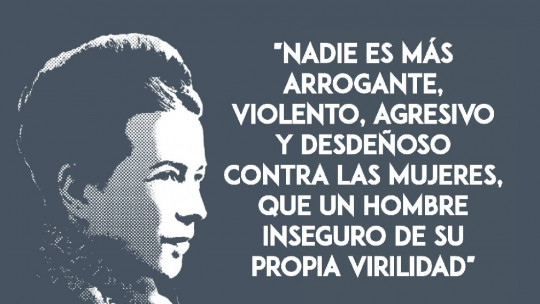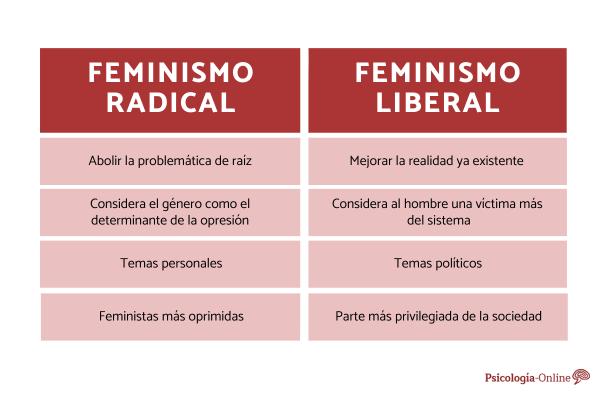
In the article on the types of feminism we already saw that it is quite complicated to talk about feminism as an ideological or political current with common objectives and ideology; In the end, for something that talks about feminisms, highlighting its plurality.
However, the fact that within this set of movements there are many very different tendencies does not mean that all of them have the same weight. Radical feminism, also known by its shortened form “radfem”, for example, is one of the most widespread and popular. Let’s see what it consists of.
The emergence of radical feminism
The radfem current appeared in the context of the second wave of feminism, started in the 70s in Western countries. Until then, feminist movements belonging to the first wave had focused on denouncing sexist discrimination expressed directly in laws and institutional rules; However, this new generation of feminists understood that oppression of women was not limited to formal sexism embodied in rules, but permeated all aspects of life.
That is, while the first feminists recognized institutionalized sexism as a fundamental problem, the second wave of feminism pointed out that the problem was of a much more complex and profound nature than that. Sexism was not only in the laws, but also in power relations, in informal treatment and, furthermore, in the material disadvantages that women faced as a consequence of centuries of submission to men.
The problem, then, was strongly rooted both in the material conditions of survival (men with many more properties and more capacity to hire, for example) and in minds (popularization of the idea that women must please men, etc. ). To end this system of oppression, called patriarchy radical feminism was born: the one that aimed to go to the root of sexism.
The characteristics of ideology
Now… what exactly is radical feminism? Fundamentally, it is a broad current of feminism that contains other smaller variants, and its basic characteristics are as follows.
1. Collectivism
The liberal feminism that defined the first members of feminisms understands that the problems of discrimination that affect women do so individually: a specific situation affects a specific woman which seeks out those others who have gone through the same thing to, together, exert pressure from their individualism.
In radical feminism, however, sex and gender inequality is a collective problem that must be addressed collectively. This means that much importance is given to the need to weave networks of solidarity that go beyond oneself. This is a characteristic born from the influence of Marxism and that is noticeable, for example, in the way in which the emphasis of the problems is not placed on specific people, but on social phenomena that are believed to perpetuate certain actions and attitudes.
For example, in the case of the appearance of scantily clad women in television products, it is very common to blame the actress, singer or presenter in question.
However, radical feminism emphasizes the need to ask why women’s bodies are constantly exploited as if it were just another audience tool, something that happens less frequently with men. Even if the women who appear scantily clad get money for it, the people who benefit most from this transaction are the chain’s senior officials, among whom female representation is scarce.
In short, we constantly talk not about individual decisions, but about what creates pronounced patterns of inequality: men do not need to use their appearance to have notoriety, but for women it is more difficult and, in any case, they will never achieve it. true power over what happens.
2. The private is political
From the perspective of liberal feminism, oppression is coercive, that is, it is expressed only through direct imposition and violence. For example, the fact that by law many women could not start working without having permission from their husband if they did not want to commit a crime was an example of what this movement rejected.
For radical feminism, however, sexism is not only expressed through clear impositions and directly expressed as such, but it is also in customs, ideals of beauty, etc. That is why in this current the private is analyzed as a political fact, since it is understood that in this area the dynamics of relationships that oppress women are also reproduced.
For example, if all the big Hollywood super-producers make films in which women always have the same psychological profile and the same plot role as amorous “damsels in distress” who need the help of the hero, that will be seen as a problem of political type for radical feminism, despite the fact that it is expressed through the private property of the large companies that offer their products.
3. A historical approach based on patriarchy
In radical feminism, patriarchy, which is theoretically formulated as the root of sexism, is not only composed of laws, but also of the cultural and material inheritance that has been bequeathed by previous generations.
Unlike liberal feminism, which does not take into account historical precedents and limits itself to pointing out injustices in the here and now, radical feminism analyzes the problem by understanding it as the product of a system of domination (patriarchy). that is reproduced century after century This is another of the influences that Marxism has had on this current, although the psychoanalysis used to study the anthropological foundations of oppression has also been an element that has favored this perspective.
4. Turn towards identity politics
In radical feminism it is considered that the fact of being a man or a woman determines irremediably the role played in the political debate. That is why this current emphasizes the need to form non-mixed groups composed only of women so that feminist consciousness can be worked on and ways to analyze problems that are not affected by the male point of view can be found.
The idea of finding new ways to express femininity that do not come from the male point of view It is highly emphasized especially by the feminism of difference, one of the main variants included within radfem.








